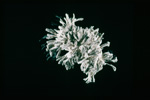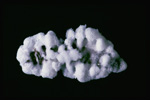Fungal control of insect and mite pests
Entomopathogens are widespread in nature and contribute to the natural regulation of insects and mites. They can be exploited for pest management in a number of ways. We are particularly interested in entomopathogenic fungi. These natural enemies are being used as microbial control agents (MCAs) of a range of insect and mite pests of horticultural and agricultural crops. Our research includes evaluating entomopathogenic fungi in different crop types. We have studied a range of pest–crop combinations, and you will find further information on these web pages.
In Europe, entomopathogenic fungi give the best results in protected crops, where the elevated temperatures and confined space suit fungal infection. The challenge now is to investigate how to utilize these valuable natural enemies for pest management in field crops, which present ecologically complex environments and where weather and climate are less favourable. This is a considerable task and should not be underestimated.
Microbial control agents are used in two main strategies:
(1) ‘Classical’ control is achieved through the introduction of a non-endemic natural enemy for the suppression of an alien (i.e. invasive) pest. A long standing hypothesis is that invasive species become pests because they have escaped their natural enemies as a result of introduction into a new area. The introduced agent is expected to establish permanently and spread within its new environment. This does not require the mass production of control agents and has been implemented mainly through government programmes. It can provide a realistic option for the control of alien species although there has been a call for improved systems for determining the effectiveness of such programmes.
(2) Augmentation control involves the application of natural enemies without the expectation of permanent establishment. It uses control agents supplied as products and has two forms:
- Inoculative applications are based on pest control through the action of individuals of the released agent and their progeny. The agent is expected to persist within the pest’s environment although without permanent establishment.
- Inundative applications achieve rapid pest control by the mass application of individuals of the released agent only, with no expectation of control by their progeny. The efficacy of inundative control agents is dose dependent.
Inundative control using microbial agents is akin to the use of chemical pesticides, which may explain why it is the most widely used form of microbial control.
In reality, inoculation and inundation form a continuum, with the control agent persisting for various amounts of time depending on its biological characteristics, the availability of hosts, the ecological stability of the environment and the cropping system. It should be noted that the inundative application of some microbial agents to control plant pathogens relies on the establishment of the agent within the local environment of the pathogen, e.g. within the rhizosphere. For this reason, augmentative microbial control agents of plant diseases are often referred to as microbial inoculants .
You can find a directory of microbial control products at the web page of the Society for Invertebrate Pathology https://www.siponline.org/.

Isaria fumosorosea

Beauveria bassiana
